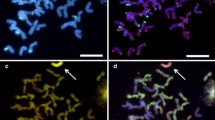Abstract
A 171ACS line (AABBDD, 2n = 6x = 42) has been crossed with the tetra-(AABB and AAGG, 2n = 4x = 28) and octoploid (AAAABBGG, 2n = 8x = 56) wheat species without the D genome, as well as with hexaploid (AABBDD and AAGGDD, 2n = 6x = 42) wheat species and tetra-(AADD, 2n = 4x = 28) and hexaploid (AADDSS, 2n = 6x = 42) amphidiploids that have the D genome. The inheritance of a novel type of spike branching in these obtained hybrid populations F1–F3 was studied. According to the results of a morphogenetic analysis of hybrid populations derived from crossings between 171ACS and wheat species without the D genome, the novel type of branching was found to be controlled by a single recessive gene (although a phenotype of the 171ACS line gives a handle for a doubt about occurrence of the second gene) and the 171ACS line is a source of the novel type branching. However, not a single branched spike plant was observed in hybrid populations that were produced by crosses of the 171ACS line with wheat species, as well as with amphidiploids that have the D genome. This result also experimentally confirmed the inhibitor effect of chromosomes of the D genome on the expression of the spike-branching trait. The appearance of branched-spike forms, together with normal spiked plants in hybrid populations of the 171ACS line and T. araraticum Jakubz. (AAGG) or T. fungicidum Zhuk. (AAAABBGG) confirmed that, as opposed to the D genome, neither genome G nor genome B demonstrated the inhibition of the expression of the spikebranching trait. In conclusion, keeping in mind that branching is exhibited in hybrid progenies obtained from crosses between the 171ACS line and wheat species with AABB and AAGG genomes, it can be said that this gene belongs to the A genome.
Similar content being viewed by others
References
Percival, J., The Wheat Plant, London: Duckworth, 1921.
Udachin, R.A. and Schakhmedov, I.Sh., New branched-ear wheat subspecies T. turgidum ssp. jakubzineri Udacz. et Schachm., Byull. Vses. Nauchno-Issled. Inst. Rastenievod. im. N.I. Vavilova, 1972, vol. 23, pp. 3–4.
Udachin, R.A. and Schakhmedov, I.Sh., New wheat species T. jakubzineri, Vestn. S-kh. Nauki, 1977, no. 2, pp. 41–43.
Flyaksberger, K.A., Pshenitsa (Wheat), vol. 1 of Kul’turnaya flora SSSR: Khlebnye zlaki (Cultural Flora of the Soviet Union: Cereals), Moscow: Gosizdat kolkhoznoi i sovkhoznoi literatury, 1935.
Koric, S., Utilization of branched genic complex for increasing for productivity of Triticum aestivum ssp. vulgare, Savrem. Poljopr., 1969, vol. 17, pp. 151–158.
Salunke, N.R. and Asana, R.D., Comparative study of the development of grain in normal- and branched-ear types of wheat (Triticum aestivum L.), Indian J. Agric. Sci., 1971, vol. 41, pp. 1050–1053.
Rawson, H.M. and Ruwali, K.N., Ear branching as a means of increasing grain uniformity in wheat, Aust. J. Agric. Res., 1972, vol. 23, pp. 551–559.
Li, W.P. and Zhao, W.M., A breeding method for increasing spikelet and studies on creation of new germplasm resource in wheat, Acta Agron. Sin., 2000, vol. 26, pp. 222–230.
Gorin, A.P., Dunin, M.S., and Konovalov, Yu.B., Praktikum po selektsii i semenovodstvu polevykh kul’tur (Practicum in Breeding and Seed Production of Field Crops), Moscow: Kolos, 1968.
Lakin G.F. Biometria (Biometry), Moscow: Visschaya schkola, 1990.
Aliyeva, A.J., Cytogenetic study of hybrid populations, produced by the cross of 171ACS line—the source of novel branched-ear types with Bereketli-95 cultivar of hard wheat, Nauch. Tr. Inst. Genet. Resur. Nats. Akad. Navuk Belarusi, 2011, vol. 3, pp. 39–47.
Aliyeva, A.J., Origin of the new branched-ear type in hard wheats, Dokl. Ross. Akad. S-kh. Nauk, 2009, no. 3, pp. 10–11.
Peng, Z.-S., Liu, D.-C., Yen, C., and Yang, J.-L., Genetic control of supernumerary spikelet in common wheat line LYB, Wheat Inform. Serv., 1998, vol. 86, pp. 6–12.
Klindworth, D.L., Williams, N.D., and Joppa, L.R., Chromosomal location of genes for supernumerary spikelet in tetraploid wheat, Genome, 1990, vol. 33, pp. 515–520.
Swaminathan, M.S. and Rao, M.V.P., Macro-mutations and subspecific differentiation in Triticum, Wheat Inform. Serv., 1961, vol. 13, pp. 9–11.
Mac Key, J., Species relationship in Triticum, in Proceedings of the 2nd International Wheat Genetics Symposium, Lund 1963, Mac Key, J., Ed., Hereditas, Suppl., 1966, vol. 2, pp. 237–275.
Morris, P. and Sears, E.R., The cytogenetics of wheat and its relatives, in Wheat and Wheat Improvement, Quisenberry, K.S. and Reitz, L.P., Eds., Agronomy Monograph, Madison: American Society of Agronomy, 1967, vol. 13, pp. 9–87.
Singh, H.B., Anderson, E., and Pal, B.P., Studies in the genetics of Triticum vavilovii Jackubz., Agron. J., 1957, vol. 49, pp. 4–11.
Luk”yanenko, P.P. and Kostin, V.V., New forms of the hard wheats, Dokl. Vses. Akad. S-kh. Nauk im. Lenina, 1970, no. 6, pp. 2–3.
Aliyeva, A.J. and Aminov, N.Kh., Inheritance of the branching in hybrid populations among tetraploid wheat species and the new branched spike line 166-Schakheli, Genet. Resour. Crop. Evol., 2011, vol. 58, no. 5, pp. 621–628. doi 10.1007/s10722-011-9702-9
Haque, M.A., Martinek, P., Kobayashi, S., et al., Microsatellite mapping of genes for semi-dwarfism and branched spike in Triticum durum Desf. var. ramosoobscurum Jakubz. “Vetvistokoloskaya”, Genet. Resour. Crop. Evol., 2012, vol. 59, no. 5, pp. 831–837. DOI 10.10.1007/s10722-011-9722-5
Dobrovolskaya, O., Martinek, P., Voylokov, A.V., et al., Microsatellite mapping of genes that determine supernumerary spikelets in wheat (T. aestivum) and rye (S. cereale), Theor. Appl. Genet., 2009, vol. 119, no. 5, pp. 867–874. DOI 10.1007/s00122-009-1095-1
Sun, D.F., Fang, J., and Sun, G., Inheritance of genes controlling supernumerary spikelet in wheat line 51885, Euphytica, 2009, vol. 167, pp. 173–179.
Author information
Authors and Affiliations
Corresponding author
Additional information
Original Russian Text © A.J. Alieva, N.Kh. Aminov, 2013, published in Genetika, 2013, Vol. 49, No. 11, pp. 1284–1292.
Rights and permissions
About this article
Cite this article
Alieva, A.J., Aminov, N.K. Influence of D genome of wheat on expression of novel type spike branching in hybrid populations of 171ACS line. Russ J Genet 49, 1119–1126 (2013). https://doi.org/10.1134/S1022795413110021
Received:
Accepted:
Published:
Issue Date:
DOI: https://doi.org/10.1134/S1022795413110021




